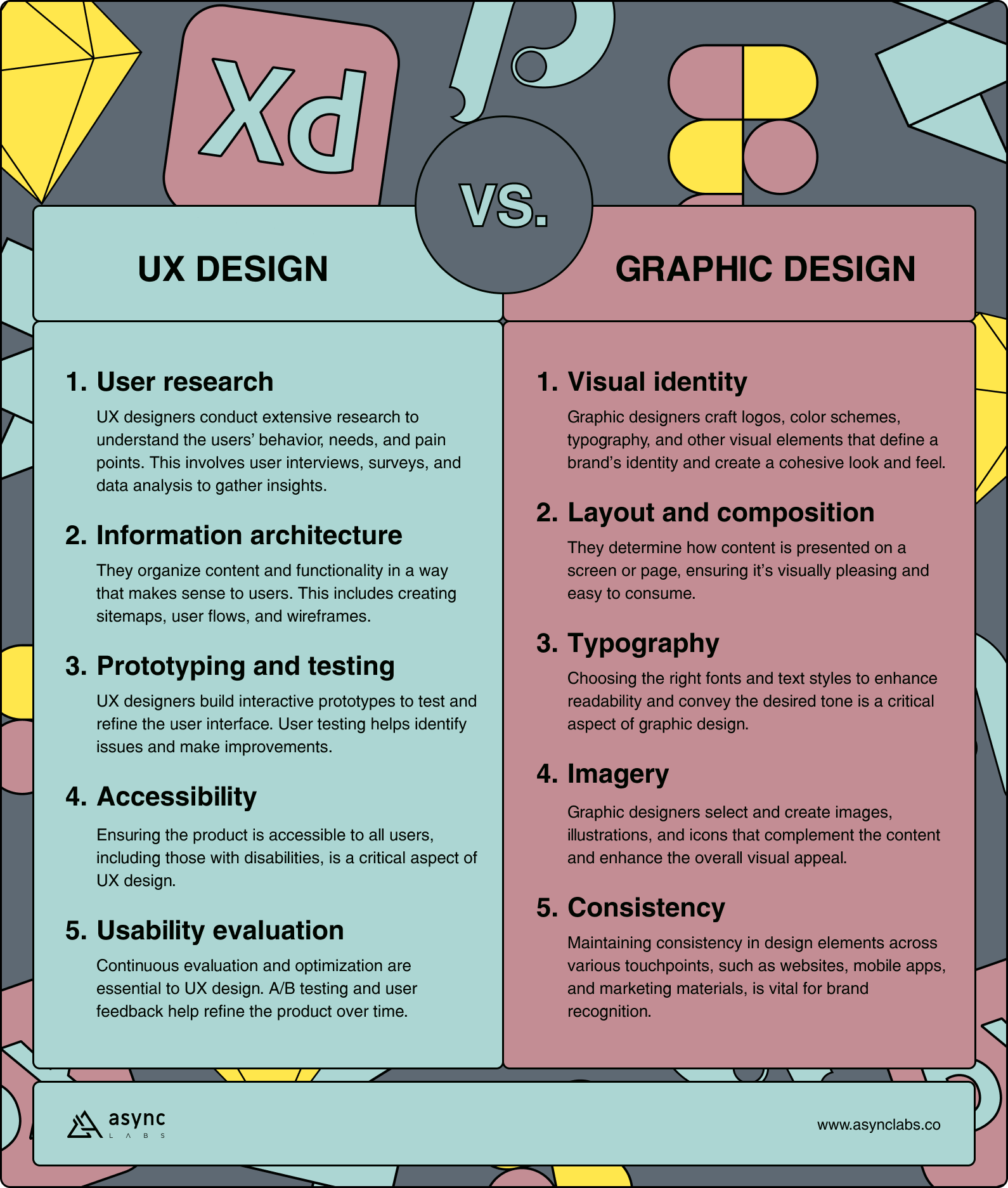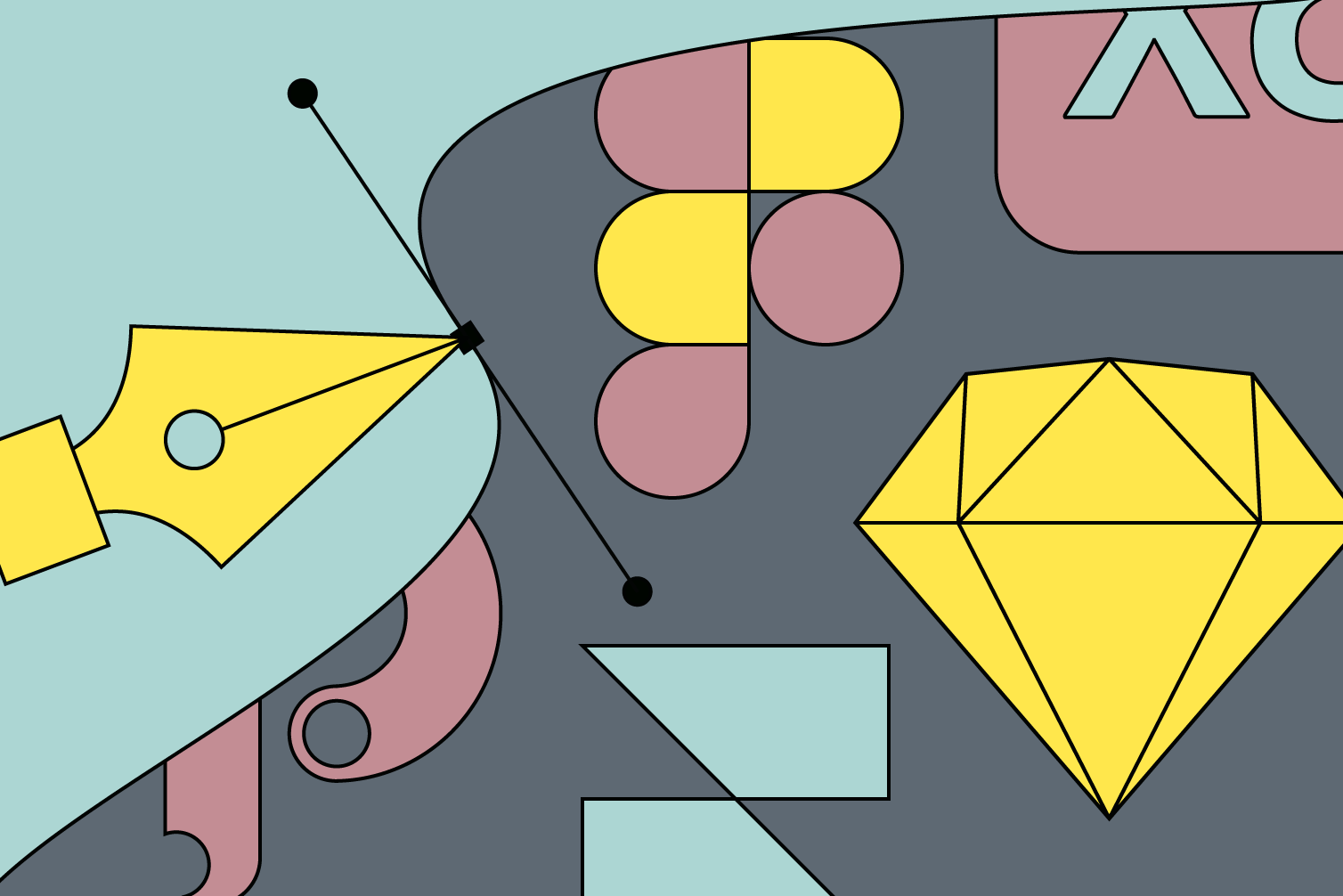Design dilemma: UX design vs. graphic design
Two terms often come to mind when designing websites, apps, and digital platforms: UX (user experience) design and graphic design. While some may believe these two are interchangeable and play crucial roles in shaping a digital product’s overall aesthetic and functionality, they are distinct disciplines with different focuses and objectives.
Both have their strengths and weaknesses, and understanding the differences can help you decide which design approach to take for your next project.
In this blog post, we’ll delve into UX design vs graphic design and explore their unique characteristics, similarities, differences, and contributions to the digital landscape.
Is UX design the same as graphic design?
Although both aim to meet user needs and business goals, UX design and graphic design are different disciplines. UX design focuses on creating a seamless and enjoyable user journey within a digital product, emphasizing functionality and usability. In contrast, graphic design primarily deals with visual aesthetics, such as typography, color schemes, and imagery, to communicate a message or enhance the overall appeal of a design.
1. Definition and goals
The first difference between UX and graphic design is their definition and goals. UX design refers to creating interfaces that are easy to use and navigate while providing a seamless experience for the user. UX design ensures users can easily interact with a product, find what they need, and meet their objectives. On the other hand, graphic design is creating visual concepts that communicate ideas or messages for various purposes. Graphic design aims to communicate the message through visuals such as typography, color, images, and layout.
2. Skillsets and mindsets
Regarding skillsets, UX designers typically know usability testing, psychology, human factors, and information architecture. They are responsible for designing user flows, wireframing, and prototyping, creating intuitive, intuitive, and accessible user interfaces while considering usability and accessibility. Graphic designers, on the other hand, need to have expertise in typography, color theory, composition, visual hierarchy, and imagery. They must be able to create visually appealing visuals and convey the intended message, such as logos, typography, branding, and marketing materials.
3. Design process
The design process is another significant difference between UX design and graphic design. UX designers typically follow a user-centered design approach, where a product’s design is based on the user’s needs, wants, and preferences. They conduct user research and usability testing to refine their design. On the other hand, graphic designers follow a visual-driven design process, starting with a design concept and then refining it by iteratively improving on visual elements such as typography, color, and composition.
4. Tools and software
Regarding tools and software, UX designers typically use prototyping and wireframing tools such as Sketch, Adobe XD, or Figma (for creating UI style guides). They also use user research and testing tools such as Maze (used for user testing in UX), Validately, or UserTesting. Graphic designers, on the other hand, use software such as Adobe Illustrator, Photoshop, and InDesign. These tools help them to create visual designs such as logos, branding, and marketing assets.
5. Collaboration and decision-making
The final difference between UX and graphic design is the level of collaboration required with other stakeholders in the project. UX designers often work closely with developers, product managers, content strategists, and other designers to ensure the product vision is aligned with the user’s needs. On the other hand, graphic designers usually work more independently, collaborating with marketing or communications teams on branding and marketing materials.
Understanding UX design: The art of user-centered design
UX design is about putting the user at the forefront of the design process. It revolves around creating intuitive, efficient, and enjoyable user experiences. UX designers are like digital architects, responsible for designing the blueprint of a digital product, ensuring it’s user-friendly, accessible, and meets the needs and expectations of the target audience.

Key responsibilities and skillsets of UX designers
- User research: UX designers conduct extensive research to understand the users’ behavior, needs, and pain points. This involves user interviews, surveys, and data analysis to gather insights.
- Information architecture: They organize content and functionality in a way that makes sense to users. This includes creating sitemaps, user flows, and wireframes.
- Prototyping and testing: UX designers build interactive prototypes to test and refine the user interface. User testing helps identify issues and make improvements.
- Accessibility: Ensuring the product is accessible to all users, including those with disabilities, is critical to UX design.
- Usability evaluation: Continuous evaluation and optimization are essential to UX design. A/B testing and user feedback help refine the product over time.
The role of graphic design: The art of visual communication
Graphic design is all about visual communication. It focuses on visually appealing elements that convey a message, evoke emotions, and establish a brand identity. Graphic designers are the artists of the digital world responsible for the aesthetic appeal of a product.
Key responsibilities and skillsets of graphic designers
- Visual identity: Graphic designers craft logos, color schemes, typography, and other visual elements that define a brand’s identity and create a cohesive look and feel.
- Layout and composition: They determine how content is presented on a screen or page, ensuring it’s visually pleasing and easy to consume.
- Typography: Choosing the right fonts and text styles to enhance readability and convey the desired tone is critical to graphic design.
- Imagery: Graphic designers select and create images, illustrations, and icons that complement the content and enhance the overall visual appeal.
- Consistency: Maintaining consistency in design elements across various touchpoints, such as websites, mobile apps, and marketing materials, is vital for brand recognition.
- Color theory: Knowledge of color theory helps designers select harmonious color schemes and create designs that evoke specific emotions or moods.
- Layout design: The ability to arrange visual elements on a page or screen in a balanced and effective manner is a fundamental skill in graphic design.
- Composition: Understanding design principles like balance, contrast, and focal points is essential for creating visually engaging designs.
- Photography: Basic photography skills can be beneficial for capturing and editing images for design projects.
- Branding and identity design: Designers often create visual identities, including logos and brand guidelines, to establish and maintain brand consistency.
- User interface (UI) design: Knowledge of UI design principles helps designers create user-friendly and visually appealing digital interfaces for websites and applications.
Synergy of UX and graphic design
While UX and graphic design have distinct roles, they are not mutually exclusive. They complement each other to create exceptional digital experiences. The synergy between the two disciplines is where the magic happens.
- Alignment: UX and graphic designers must work closely to ensure the user interface (UI) elements align with the overall design and branding guidelines. This creates a seamless and visually appealing experience.
- Visual hierarchy: Graphic design principles, such as contrast, color, and typography, are crucial in establishing a clear visual hierarchy within a digital product. This guides users’ attention and enhances usability.
- User engagement: Compelling graphics and visuals can enhance user engagement, making the product more enjoyable. This is where graphic design can significantly impact users’ emotional connection with a product.
- Feedback loops: Regular collaboration between UX and graphic designers facilitates feedback loops, allowing for continuous improvements and optimizations in user experience and visual design.
Conclusion
UX and graphic design are two distinct pillars with different goals, skill sets, and design processes. While the fields may overlap in some areas, understanding the differences can help stakeholders and clients choose the ideal approach for a particular project.
Although they have different focuses, they also intertwine in the pursuit of crafting digital experiences that captivate users. The successful combination of UX design’s user-centric approach and graphic design’s visual storytelling can lead to digital products that work well and look and feel fantastic.
Ultimately, this harmonious combination drives user satisfaction and ensures a lasting impact in the digital landscape.
Elevate your brand’s user experience and visual appeal – explore our UX design and graphic design services today.
